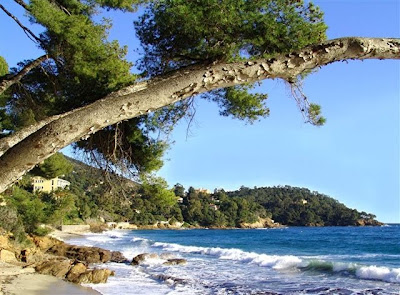
Fiji beaches, Yasawa Islands
Fiji is one of the closest Pacific island groups to New Zealand [1,600kms/1,000miles to the south] and Australia [2,700kms to the southwest], so flights are reasonably short and cheap from these English-speaking countries. [New Caledonia is nearer to Australia and French Polynesia the furthest major island group. Easter Island is away further east....]
Fijians are a relaxed and friendly people, cheerfully shouting the greeting "Bula!" [Health!] to any foreign traveller, a far cry from a hundred years ago in their cannibal era when they would shout "Dinner!" if they saw a white face, and reach for their four-prong, human flesh forks. Missionary eyeballs were especially succulent when barbecued apparently.
Nearly half of Fiji's indigenous population are of Indian extraction, brought in by the British to work in the sugar cane industry in the late 1880's as the relatively enlightened colonialists did not wish to exploit the local Melanesians. Unfortunately the 'Fiji for the Fijians' system, while permitting Melanesians to continue owning their land and governing their own villages didn't do much for the rights of the Indians, an inequality that still burns today.
The upside of the racial mix is that the Indians are often more industrious than the laid-back Melanesians and have helped to develop and maintain the country's infrastructure, particularly with relation to tourism, though the Indians can be aggressive in their pursuit of the dollar. When changing money here tourists would do well to carefully check and double check rates and cash handed over.
Fortunately, though these two racial groups maintain fundamentally different life styles and rarely intermix, they co-exist with reasonable harmony and the country benefits from both attitudes.
Fiji's high-speed, low cost Yasawa Island's ferry, the Yasawa Flier.
Fiji comprises two large islands and around 300 small ones, so some upfront planning is essential here.
Viti Levu island is where most travellers arrive and hosts a lot of attractions, including golf, fishing and boating for the more affluent, or cultural tours, village visits, sandboarding, Highland hiking, rafting, tubing and bathing in hot mud pools for the rest of us. Nadi, an Indian-dominated town, is good for shopping but little else including accommodation.
Viti Levu also offers excellent beach hotels to suit all pockets, though the actual beaches and coral are not nearly as good as on other islands. The Coral Coast to the south is the usual starting point for beachgoers.
Some popular and extensive island bus tours cater specifically to backpackers.
Suva is Fiji's capital, on the other side of Viti Levu from Nadi and a cosmopolitan high-rise city that is short on interest for most travellers.
Vanua Levu, the other big island, north of Viti, is more wet and less developed than Viti, with few tourist-oriented options or transport, but much more of a feel of the old South Seas. The south side of the island with its coconut plantations and relaxed villages is particularly redolent of a bye-gone era.
Although the countryside feels primitive there are many excellent resorts in North Fiji, with scuba as the top attraction. The Somosomo Straits between Vanua Levu and Taveuni offer some particularly spectacular coral. Visibility is best May-October.
Botaira Beach Resort welcoming guests with the usual tuneful island song, but unusually afloat.
The Yasawa Islands, a chain of a dozen up to four hours from Viti Levu by the Flyer are - with the exception of the furthest, Yasawa Island itself - low cost and low profile places, providing basic services and activities, with snorkelling and kayaking topping the list. The islands are visited daily - [again, not Yasawa Island] by the Yasawa Flyer catamaran, lugging backpackers and flashpackers to and fro, some staying their entire time on one island, others hopping from one to another every couple of days.
For those prone to seasickness the waters around the Yasawa Islands are partly protected and the ride not too bouncy; maximum trip time to/from the furthest island is four hours.
The Yasawas are mostly powered by electricity generators so lighting is limited and air-con nonexistent; islands mostly offer simple thatched bungalows and communal meals. Beaches are generally small and unmanicured but pleasant, with pretty fair coral right near the beach, though these are not by any stretch of the imagination the world's best beaches. However...
Yasawa Island hosts a couple of the best beaches in Fiji and possibly in the world, with its northerly beaches coming out on top and visited by the famous and costly Blue Lagoon Cruise ships. Otherwise Yasawa Island is home to an expensive hotel, the Yasawa Island Resort that needs to be reached by plane or via several hours on a water taxi.
The Mamanuca Islands - on the way to the Yasawa chain and just off Viti Levu are perfect for the time short or very sea sensitive. They are a slightly more sophisticated and comfortable cluster of tiny islands - with air conditioning and mains electricity- that can work as a day trip or overnight stay. The Yasawa Flyer only takes 30 mins to South Sea, 5 more minutes to Bounty and Treasure, another 10 minutes to Beachcomber Resort [pictured above]. Easy peasy. The next island, Kuata, takes another hour.
The following pictures are mainly of Yasawa Islands beaches, but not, unfortunately of Yasawa Island itself - we also have budgetary constraints and that was a beach too far!
North and West coasts are drier due to prevailing winds, so choose a beach resort on one of those coasts if travelling in the wet season.
Visas: A 4 month visa is available on arrival to just about anyone owning a passport and a return flight ticket.










_(494416736).jpg)





















 Broadstairs beach, Kent
Broadstairs beach, Kent